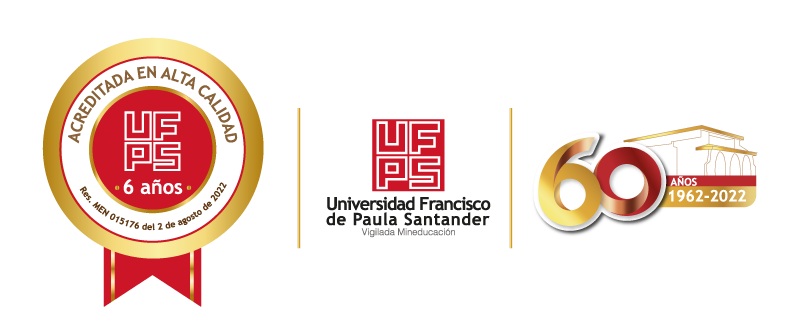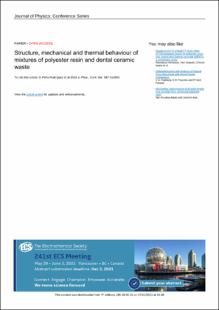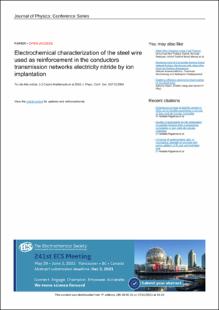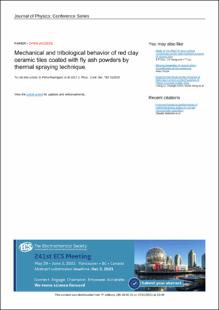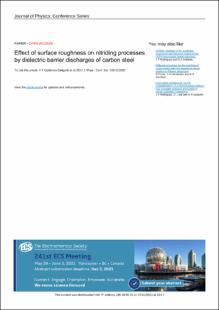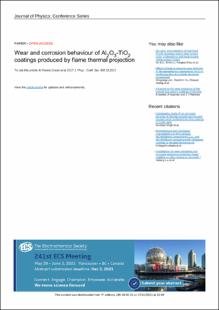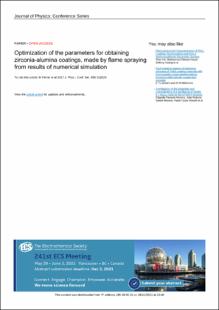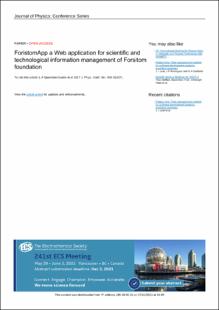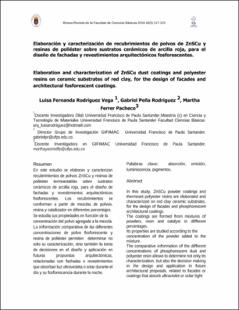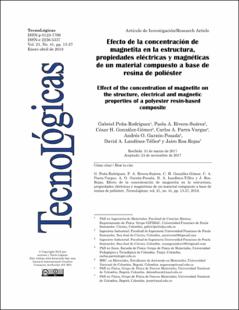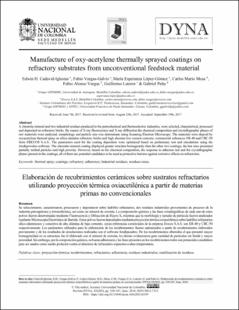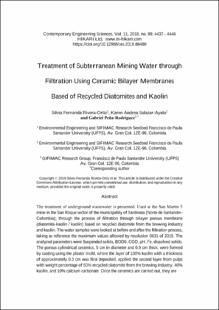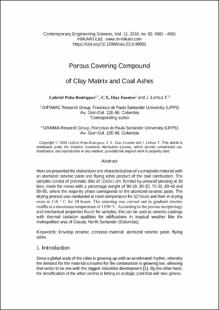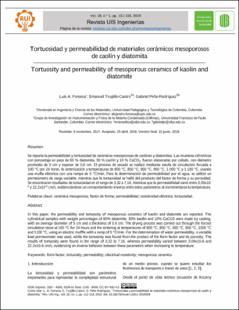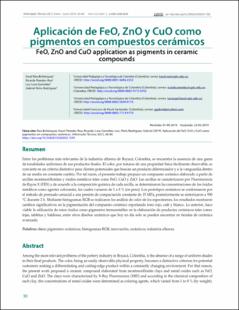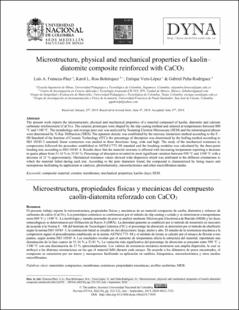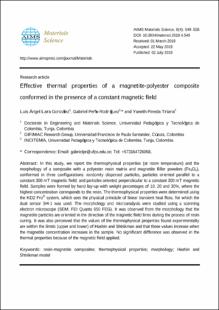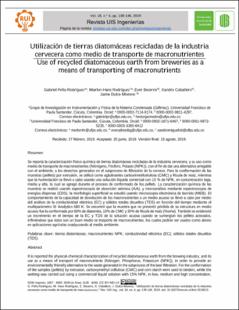Listar Instrumentación y Física de la Materia Condensada – GIFIMAC por fecha de publicación
Mostrando ítems 1-20 de 39
-
Structure, mechanical and thermal behaviour of mixtures of polyester resin and dental ceramic waste
(Journal of Physics: Conference SeriesLondres, Reino Unido, 2016-02-12)The tensile strength and bending strength, structure and thermal behaviour of mixtures of polyester resin (P-2000) and powders (ASTM sieve 200, <75μm) of dental ceramic wastes (dentals impressions, alginate and gypsum) was ... -
Electrochemical characterization of the steel wire used as reinforcement in the conductors transmission networks electricity nitride by ion implantation
(Journal of Physics: Conference SeriesBogota , Colombia, 2016-02-12)The power company feature infrastructure, which are generally shaped so the transmission and distribution lines, here is why it is necessary to characterize the process of electrochemical corrosion of these components. In ... -
Mechanical and tribological behavior of red clay ceramic tiles coated with fly ash powders by thermal spraying technique
(Journal of Physics: Conference SeriesBogota , Colombia, 2017)The mechanical and tribological performance of red clay ceramic tiles uncoated and coated by oxy-fuel thermal spraying process from fly ash powders was evaluated. The ceramic tile substrates were manufactured by uniaxial ... -
Effect of surface roughness on nitriding processes by dielectric barrier discharges of carbon steel
(Journal of Physics: Conference SeriesBogota , Colombia, 2017-12-29)Changes in the behaviour of steels to carbon, for three different finishes, surfaces were determined to be nitride by atmospheric pressure dielectric barrier discharge. The surfaces were characterized both morphologically ... -
Projection parameters for zirconia-alumina-ceria coatings made by flame spraying from results of numerical simulation
(Journal of Physics: Conference SeriesLondres, Inglaterra, 2017-12-29)A numerical simulation was performed with the software Jets et Poudres, the results let choose the parameters to deposit zirconia-alumina-ceria coatings of different composition on substrates of red clay, by thermal spraying ... -
Wear and corrosion behaviour of Al2O3-TiO2 coatings produced by flame thermal projection
(Journal of Physics: Conference SeriesBogota , Colombia, 2017-12-29)Evaluated the wear resistance and the coatings corrosion behaviour of Al2O3-TiO2 prepared by thermal spraying by flame on AISI 1020 carbon steel substrates, previously coated with an alloy base Ni. For this purpose, were ... -
Optimization of the parameters for obtaining zirconiaalumina coatings, made by flame spraying from results of numerical simulation
(Journal of Physics: Conference SeriesLondres , Inglaterra, 2017-12-29)The K-Sommerfeld values (K) and the melting percentage (% F) obtained by numerical simulation using the Jets et Poudres software were used to find the projection parameters of zirconia-alumina coatings by thermal spraying ... -
ForistomApp a Web application for scientific and technological information management of Forsitom foundation
(Journal of Physics: Conference SeriesBogota , Colombia, 2017-12-29)Information and Communication Technologies (ICT) are essential in the transfer of knowledge, and the Web tools, as part of ICT, are important for institutions seeking greater visibility of the products developed by their ... -
Elaboración y caracterización de recubimientps de polvos de ZnSCu y resinas de poliester sobre sustratos cerámicos de arcilla roja, para el diseño de fachadas y revestimientos arquitectónicos fosforescentes
(Bistua Revista De La Facultad De Ciencias BasicasBogota , Colombia, 2018)En este estudio se elaboran y caracterizan recubrimientos de polvos ZnSCu y resinas de poliéster termoestables sobre sustratos cerámicos de arcilla roja, para el diseño de fachadas y revestimientos arquitectónicos ... -
Efecto de la concentración de magnetita en la estructura, propiedades eléctricas y magnéticas de un material compuesto a base de resina de poliéster
(TecnoLógicasBogota , Colombia, 2018-01-15)Se reporta el efecto de la concentración de polvos de magnetita (Fe3O4) sobre las propiedades eléctricas y magnéticas de un material compuesto a base de resina de poliéster termoestable. Las muestras se elaboraron mediante ... -
Manufacture of oxy-acetylene thermally sprayed coating on refractory subtrates from unconventional feedstock material
(DYNABogota , Colombia, 2018-04-01)A chromite mineral and two industrial residues produced in the petrochemical and thermoelectric industries, were selected, characterized, processed and deposited on refractory bricks. By means of X-ray fluorescence and ... -
Water treatment using porous ceramics based on recycled diatomite and kaolin
(Contemporary Engineering SciencesSofia , Bulgaria, 2018-09-06)The treatment of waters using filtering process through sintered porous ceramics based on diatomite and kaolin is reported. The water samples were prepared in low = 50%, medium = 100% and high = 150% concentrations, ... -
Treatment of subterranean mining water through filtration using ceramic bilayer membranes based of recycled diatomites and kaolin
(Contemporary Engineering SciencesSofia , Bulgaria, 2018-10-22)The treatment of underground wastewater is presented. Used at the San Martín 5 mine in the San Roque sector of the municipality of Sardinata (Norte de SantanderColombia); through the process of filtration through bilayer ... -
Porous covering compound of clay matrix and coal ashes
(Contemporary Engineering SciencesSofia , Bulgaria, 2018-11-05)Here are presented the elaboration and characterization of a composite material with an atomized ceramic paste and flying ashes product of the coal combustion. The samples consist of prismatic tiles of 10x5x1 cm, formed ... -
Tortuosidad y permeabilidad de materiales cerámicos mesoporosos de caolín y diatomita
(Revista UIS IngenieríasBogota , Colombia, 2019-01-01)Se reporta la permeabilidad y tortuosidad de cerámicas mesoporosas de caolines y diatomitas. Las muestras cilíndricas con porcentaje en peso de 60 % diatomita, 30 % caolín y 10 % CaCO3, fueron elaboradas por colado, con ... -
Design and manufacture of the cooling system of JUPITER reactor
(Journal of Physics: Conference SeriesBogota , Colombia, 2019-02-25)The experimental investigations carried out in the Plasma laboratory of the Universidad Industrial de Santander, on superficial modification of metallic materials by hybrid discharges of high-voltage and electric arc at ... -
Aplicación de FeO, ZnO y CuO como pigmentos en compuestos cerámicos
(Informador TécnicoBogota , Colombia, 2019-04-12)Entre los problemas más relevantes de la industria alfarera de Boyacá, Colombia, se encuentra la ausencia de una gama de tonalidades uniformes de sus productos finales. El color, por tratarse de una propiedad física ... -
Microstructure, physical and mechanical properties of kaolin - diatomite composite reinforced with CaCO3
(DYNA, 2019-07-01)The present work reports the microstructure, physical and mechanical properties of a material composed of kaolin, diatomite and calcium carbonate reinforcement (CaCO3). The ceramic prototypes were shaped by the slip casting ... -
Effective thermal properties of a magnetite-polyester composite conformed in the presence of a constant magnetic field
(AIMS Materials ScienceWashintong D.C , Estados Unidos, 2019-07-02)In this study, we report the thermophysical properties (at room temperature) and the morphology of a composite with a polyester resin matrix and magnetite filler powders (Fe3O4), conformed in three configurations: randomly ... -
Use of recycled diatomaceous earth from breweries as a means of transporting of macronutrients
(Revista UIS IngenieríasBogota , Colombia, 2019-09-16)Se reporta la caracterización físico-química de tierras diatomáceas recicladas de la industria cervecera, y su uso como medio de transporte de macronutrientes (Nitrógeno, Fósforo, Potasio (NPK)), con el fin de dar una ...
